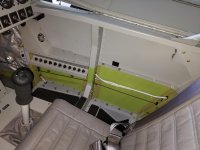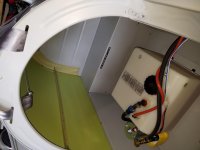I've been working on my RV-14 horizontal stabilizer and have all the parts ready to prime before assembly. I'm going to be using Akzo and a 3M Accuspray paint gun for the first time. I have everything ready to go but I have some questions.
1- I will be paining all the parts for the horizontal stabilizer - which isn't very many really. Does anybody have any idea how much paint I need to mix? Would 8oz be enough? I plan to do one coat.
2- I'm assuming I will get some overspray on the "outside" of the skins. Do folks mask the outside of the skins to prevent this or do you just let the finish painter remove it before painting?
3- I'm using the Mixing Mate paint can lids for the 1g Akzo cans. These are the things that stay on the can and have a built in stirring wand. I wore a full face 3M mask with filters while installing them but afterwards (like 30 minutes later) I could smell a slight chemical odor. I didn't spill a drop while putting the lids on so I'm wondering where this smell is coming from. Can vapors escape around the shaft of the stirring wand/handle? That is the only place in the lid that I would guess vapors could escape from. Kinda bummed because these things looked like a great solution to avoid spilling paint and get precise amounts dispensed each use.
Thanks for your help!
1- I will be paining all the parts for the horizontal stabilizer - which isn't very many really. Does anybody have any idea how much paint I need to mix? Would 8oz be enough? I plan to do one coat.
2- I'm assuming I will get some overspray on the "outside" of the skins. Do folks mask the outside of the skins to prevent this or do you just let the finish painter remove it before painting?
3- I'm using the Mixing Mate paint can lids for the 1g Akzo cans. These are the things that stay on the can and have a built in stirring wand. I wore a full face 3M mask with filters while installing them but afterwards (like 30 minutes later) I could smell a slight chemical odor. I didn't spill a drop while putting the lids on so I'm wondering where this smell is coming from. Can vapors escape around the shaft of the stirring wand/handle? That is the only place in the lid that I would guess vapors could escape from. Kinda bummed because these things looked like a great solution to avoid spilling paint and get precise amounts dispensed each use.
Thanks for your help!






